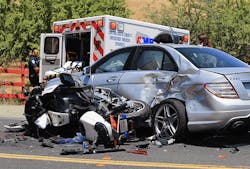The National Safety Council (NSC) estimates traffic deaths are 14 percent higher through the first six months of 2015 than they were during the same period in 2014, and serious injuries are a whopping 30 percent higher. Costs are up as well. The six-month estimated bill for traffic deaths, injuries and property damage is $152 billion – 24 percent higher than 2014.
From January to June, nearly 19,000 people died in traffic crashes across the United States, and more than 2.2 million were seriously injured, putting the country on pace for its deadliest driving year since 2007.
"Follow the numbers: the trend we are seeing on our roadways is like a flashing red light – danger lies ahead," said Deborah A.P. Hersman, president and CEO of NSC. "Be a defensive driver and make safe decisions behind the wheel. Your life really depends on it."
While the high death and injury toll could be due to many factors, an improving economy with lower gas prices and unemployment rates herald increases in vehicle miles traveled. Average gas prices are 30 percent lower than they were in 2014 and are projected to remain relatively stable heading into 2016. This generally means an increase in traffic; more people can afford to drive, and many travel longer distances and take vacations.
To help ensure safety, the council recommends drivers:
- Make sure every passenger buckles up on every trip.
- Designate an alcohol- and drug-free driver or arranging alternate transportation.
- Get plenty of sleep and take regular breaks to avoid fatigue.
- Never use a cell phone behind the wheel, even hands-free.
- Stay engaged in teens' driving habits. Teens are three times as likely to crash as more experienced drivers.
- Learn about your vehicle's safety systems and how to use them. My Car Does What can help drivers understand the ins and outs of features such as adaptive cruise control, blind spot warning systems and backup cameras.
About the Author

Sandy Smith
Sandy Smith is the former content director of EHS Today, and is currently the EHSQ content & community lead at Intelex Technologies Inc. She has written about occupational safety and health and environmental issues since 1990.
